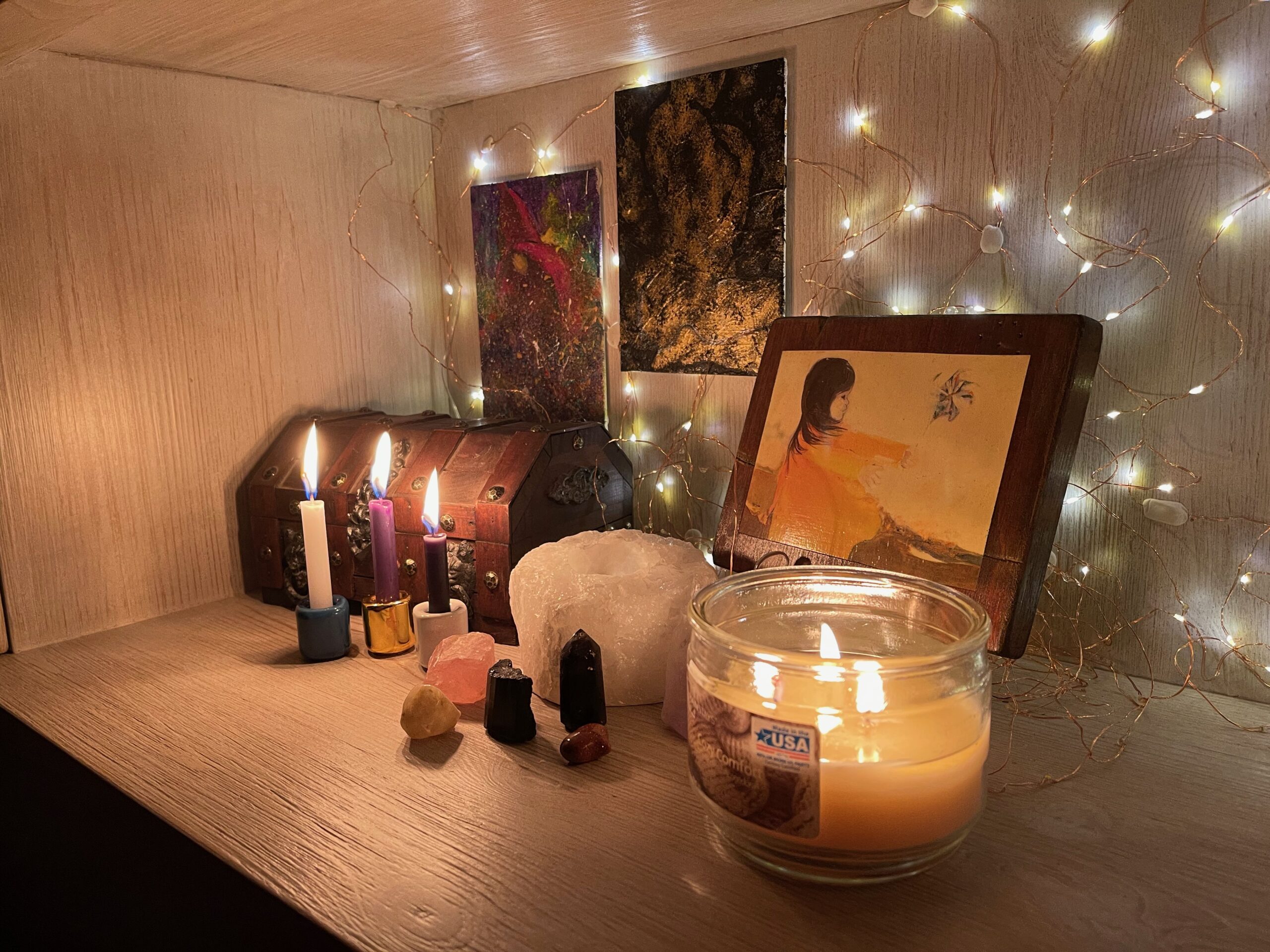Greetings, Brave One (Yes, I’m talking to you. It takes immense bravery to face our trauma. Take a deep breath and thank yourself for being here). Today, I’m sharing about something very close to my heart: the connection between childhood and spiritual trauma and Complex Post-Traumatic Stress Disorder (CPTSD) in adult women.
Now, before you close this tab in fear of a heavy read, let me assure you that this won’t be a dreary dissertation on the effects of trauma. Instead, I’m going to share some insights that I’ve gathered through my years of experience as a therapist and a client who has CPTSD.

What is CPTSD?
It’s a condition that affects people who have experienced prolonged, repeated trauma, such as childhood abuse, neglect, domestic violence, or religious abuse. Sadly, women are 2-3 times more likely than men to develop PTSD after exposure to trauma.
Now, before we get into the nitty gritty of what CPTSD looks like in our everyday lives, I encourage you to think about this with self-compassion and hope. When we learn about our psyche, it can be so easy to go back to the pattern of blaming and shaming ourselves for being defective. If you relate, this is your reminder that you had a normal response to abnormal, traumatic situations. Please, be gentle & kind to yourself as you continue.
What’s different about CPTSD and PTSD?
CPTSD is similar to PTSD, but it includes additional symptoms, such as emotional dysregulation, interpersonal difficulties, a negative self-concept, and more. These symptoms profoundly impact our daily life.
Oftentimes, these symptoms seem normal because they’ve developed during childhood and we don’t know anything differently. If the symptoms develop in adulthood, these symptoms are often still difficult to recognize because it develops over a long period of time, and we don’t recognize the subtle changes as they’re occurring.

What does CPTSD look like?
Emotional Dysregulation
CPTSD impacts how we function in relationships, work, home, and, really, all aspects of life. For example, you may struggle with emotional dysregulation. In my experience, this looks like feeling emotions on the extremes. I can be numb and have imperceptible reactions to situations that probably need a bigger response. On the other end of the spectrum, I feel things so intensely that I have a much bigger reaction to a seemingly insignificant situation.
***side note*** When I dig deeper into these intense emotions with curiosity (rather than judgment), I find that these reactions are tied to past traumatic experiences. These big feelings on both sides of the spectrum have important, life altering messages for us.
Okay, back to emotional dysregulation. Others might describe it as experiencing frequent mood swings, having a low tolerance for stress, and feeling easily triggered by everyday experiences. These symptoms can make it challenging to maintain healthy relationships because you may struggle with effective communication or feel overly reactive to your partner’s behavior. For some, this means that we bail out on relationships before we give the relationship a real chance. For others, it means that we stay too long in unhealthy relationships.
CPTSD forming from relational trauma
CPTSD forms from relational trauma, meaning that we experienced trauma within relationships that were supposed to be safe. This happens when caregivers fail to give us the love, attention, and nurturance that’s necessary to develop important life and relationship skills.
Religious abuse could also be considered relational trauma because someone we trusted used their relationship with us and religion to manipulate, control, and cause harm.
Those who grow up in CPTSD engendering homes learn that others aren’t safe and that communicating with others isn’t safe. Then, if there are other experiences of relational trauma and/or other traumas, it reinforces the beliefs about the world and others being unsafe.
Interpersonal Difficulties
As you can imagine, this creates an environment primed for interpersonal difficulties, and this is another hallmark of CPTSD. This often looks like simultaneously keeping people too close and pushing people away; having a deep fear of abandonment; compulsive, chronic people pleasing; difficulty with setting and maintaining appropriate boundaries; and fear of vulnerability and intimacy.
Ultimately, when we aren’t able to get our needs met in relationships, we end up feeling frustration, anger, and resentment. For some people, this leads them to believe that they aren’t meant for relationships and they isolate themselves from others because it feels safer.
Negative Self-Concept
A negative self-concept can also be a challenging symptom of CPTSD. This looks like struggling with feelings of shame, self-blame, and a pervasive sense of worthlessness. You may feel like you are fundamentally flawed or broken, and may struggle to see yourself as deserving of love and compassion. This can make it difficult to practice self-care, and may lead to a cycle of self-destructive behaviors, such as substance abuse or self-harm.
How does childhood and spiritual trauma contribute to CPTSD?
There is a saying that sums this up, “neurons that fire together, wire together.” But, what does that even mean?
I alluded to it earlier. Our experiences reinforce our learning (good or bad). I often describe this as an old dirt road with deep ruts. The more the dirt road is traveled, the deeper the ruts get and the more challenging it is to go on a different route.
Each experience we have is an opportunity to create a new neural pathway or reinforce an old neural pathway in our brain, and this is why understanding emotional flashbacks is imperative to healing.
An emotional flashback is another primary symptom of CPTSD. These feel like we’re reliving a past trauma but without having the visual cue or even memory reminding us what the felt experience is about.
In essence, it’s like having the ghosts of all your past experiences haunting you yet not even being able to recognize what’s happening. As you can imagine, this becomes extremely disorienting and causes you to doubt your own experiences.

Now, if your outlook tends to be on the darker side of life, which let’s face it, if you’re still reading, it’s a high likelihood, you’ve probably concluded that all of this means that you’re stuck in this perpetual cycle of dreariness. But, you’d be wrong, my brave friend. There is hope!
This also means our brains have the power to heal. The more time you put into creating and reinforcing new neural pathways, the more likely you are to be able to literally change your brain and thereby your life.
3+ ways to create and reinforce new neural pathways
1. Therapy
Yeah… of course a therapist recommends therapy.
For real, though, not all therapy works. In fact, you can find yourself with a therapist that does you more harm than good which is why it’s so important for you to trust yourself on this one.

Here are some things to consider when trying to find the right therapist for you:
The most important factor in effective therapy is the therapeutic relationship, so keep this as your top priority when searching for a therapist.
If you meet a therapist and you’re not feeling a good vibe, don’t go back. Typically, I suggest giving yourself a few sessions to feel it out, but if you feel alarmed or unsafe, trust it and don’t go back.
Don’t get too caught up in the therapeutic flavor of the month. Therapeutic approaches seem to go through trends. Yes, these are evidence-based trends, but I’m mostly trying to point out that there is no magic bullet, especially for CPTSD.
Sometimes therapeutic approaches advertise in a way that makes them seem like the cure all. If you’re too caught up on finding a therapist that offers a particular type of therapy, you might find yourself investing into an approach rather than a productive, healing relationship.
Additionally, many therapists nerd out on therapeutic approaches. They might be in the process of learning the approach and don’t have it on their marketing materials yet. If you find a therapist that you think might be a good fit, get in touch with them, ask them about their approach, and give it a try if it still feels like it might be a good fit.
Final tip from me: Don’t stay in a therapeutic relationship that isn’t working. You may really like the therapist as a person and even gained some insight and healing within that relationship, but if you’re feeling stuck, explore that feeling.
Talk with the therapist about it. You could even give yourself a time-frame for when you’d like to see some more progress and reevaluate later. Sometimes, we outgrow the therapeutic relationship, and it’s okay to recognize that and move forward with someone else or take a break.
For some more tips on finding a good therapist, check out this blog post…
2. Self-care
I know. This word is so overused that I also cringe when hearing it. Add that to the fact that it’s been weaponized to gaslight us into believing that we’re defective because it’s somehow our fault that we’re unable to manage the unrealistic expectations set forth by capitalism, and I’m ready to throw things at people when they say it.
So, instead of *that word*, let’s substitute it with prioritizing your needs. When you don’t prioritize yourself, you further entrench the beliefs you learned through trauma. Choosing yourself, teaches you that you are worthy of love and care. In fact, when you teach yourself what being worthy looks and feels like, you’ll start to automatically expect to be treated with the same respect, love, and care that you give yourself from others

What does prioritizing your needs look like?
Simply put, you’re checking-in with your body, listening to its cues, and giving yourself the love, care, and attention you deserve. Sometimes this means you take a bubble bath, meditate, spend time with a friend, do some art, or get out in nature.
Other times, it’s less fun; it means you’re cleaning up your space because you deserve to live in a clean, aesthetically pleasing place. Maybe it means that you go to the doctor so you can have peace of mind about a physical ailment that’s been bothering you. Your needs change, so it’s important to check-in frequently and let your body be your guide as you learn to care for yourself.
3. Engaging in spiritual practices
If you’ve experienced spiritual abuse, your eyes may have just rolled to the back of your head. I know that only a few years ago, mine would have too, but hear me out.

When I’m saying spiritual practices, I mean practices that facilitate a meaningful connection to psyche. For a time, I cut myself off from anything remotely spiritual. If that’s where you’re at, I understand that you may not be ready right now and that’s okay.
For me, I’ve found incredible healing and empowerment in reclaiming my spirituality and making it my own. I’m immensely grateful that my therapist gently pushed me to explore my spirituality. I truly believe that if I hadn’t started taking those shaky steps of self-discovery, that I wouldn’t have some of my most treasured and transformative moments of my life.
6 ways to engage in spiritual practices after Spiritual Trauma
Take it slowly.
Start with small steps & listen to your body (noticing a theme?). If you notice that you’ve gone too far beyond your comfort level, slow down, pause, or stop. You can try again later or ditch that practice altogether and try something different. You get to choose.
Get curious!!
What do you want to learn about? What cultures are you interested in? It’s the information age and you’ve got the entire world to safely explore from your home using the internet. Go down a rabbit hole on YouTube, TikTok, Reddit, or wherever you like and learn about other people, cultures, science, quantum physics, religions, other spiritual practices & rituals, animals, countries, etc. I promise, your curiosity is productive. It’s an avenue to discover who you are rather than who you think you’re supposed to be.
In that note, begin asking yourself, “who benefits from my believing ___?” For example, who benefits from the belief that sex is reserved for marriage? (For this question to work, it requires you to be really honest with yourself).
Do the forbidden.
For example, maybe you decide to visit a local, metaphysical shop because it was “evil” and “new age.” So, test out the belief… is it really evil? What’s the worst that could happen? You see some trinkets, rocks & crystals, books, etc. that peak your curiosity or you find that it’s not for you. Either way, you survived the “evil” metaphysical shop and learned that God didn’t immediately smite you for just thinking about it.
Be intentional.
Feeling compelled to clean the house or take a shower? Perhaps that’s a reflection of what you’re feeling within your psyche. Maybe it’s time to use that cleaning time to imagine you’re also cleansing your spirit & mind.
Maybe you’re feeling stuck. Perhaps your body is saying it’s time to turn on Taylor Swift’s “Shake It Off” or Florence and the Machine’s “Shake it Out” and imagine yourself shaking off what’s feeling stuck while you literally shake and move your body.
The Christian church defamed the word ritual and associated it with evil. These are examples of rituals. You get to determine what rituals you want to do. You don’t need to follow anyone else’s lead. Just connect with your intuition and follow that.
Go outside.
The restoration magic that comes from slowing down, getting in nature, and noticing the beauty of the world around us is almost unparalleled to anything else. Take pictures of sunsets, beautiful plants, trees, bugs, or whatever captures your attention. Make a mandala using sticks, feathers, acorns, rocks, etc. Imagine you’re a little kid who has never seen or experienced nature before and play & explore like you’re that little kid. For inspiration, check out the TikTok.
@novas_adventures_ Replying to @definitelynotacop What do we do with the stick? We went inside a tree!! #naturetherapy #mentalhealthawareness #outdoorlife #natureheals #naturelovers #mindfulnessinnature #innerchild#natureandmentalhealth #greentherapy #naturewalk #healingwithnature #grass #dailygrass #nature #adventure #explore #ptsd #cptsd ♬ original sound - Novas Adventures💚🌲
Get in touch with your sexuality.
Sexuality and spirituality are closely intertwined. Both require that you’re in touch with your body. Do you know what brings you pleasure? I’m talking about more than sexual pleasure. I’m talking about understanding what ignites you and makes you feel alive. Yes, orgasms do that, but so does slowly eating a chocolate covered strawberry and intentionally noticing the texture and tastes play on your tongue.
Practice gratitude for your body & for the pleasure it allows you to experience. Make pleasure a priority by incorporating it into habits you already have (ie- eating; drinking; showering; getting dressed, etc.) What small changes can you make to bring pleasure to your everyday routine?
Give yourself permission to touch and explore your entire body. Figure out what feels good to you. Look at your naked body in the mirror. Turn on music that makes you feel sexy and move your hips. Dress the way that makes you feel like a sexy goddess.
1 Daily Practice You can Implement Today
Now for the long awaited practice that you can start incorporating into your daily routine to help you to start rewiring your brain. I’m not sure who to credit for this, but it’s a practice I learned while working at a domestic violence shelter.
Take time out of your day to celebrate BAGS. Huh?
It’s an acronym for the following:
B = Best moment of the day.
A = Accomplishment of the day.
G = 3 new things you’re grateful for.
S = Something new you learned today.
How it works
Our brains are wired to look for the negative. This sounds depressing, but in reality, it’s pragmatic. If we don’t remember the threats to our survival, we’ll keep making the same mistakes and die. Practicing BAGS gives you the opportunity to actively look for the positive things in your life and celebrate them. You can practice this on your own and/or with loved ones. Either way, try it and see how it starts changing your day.
